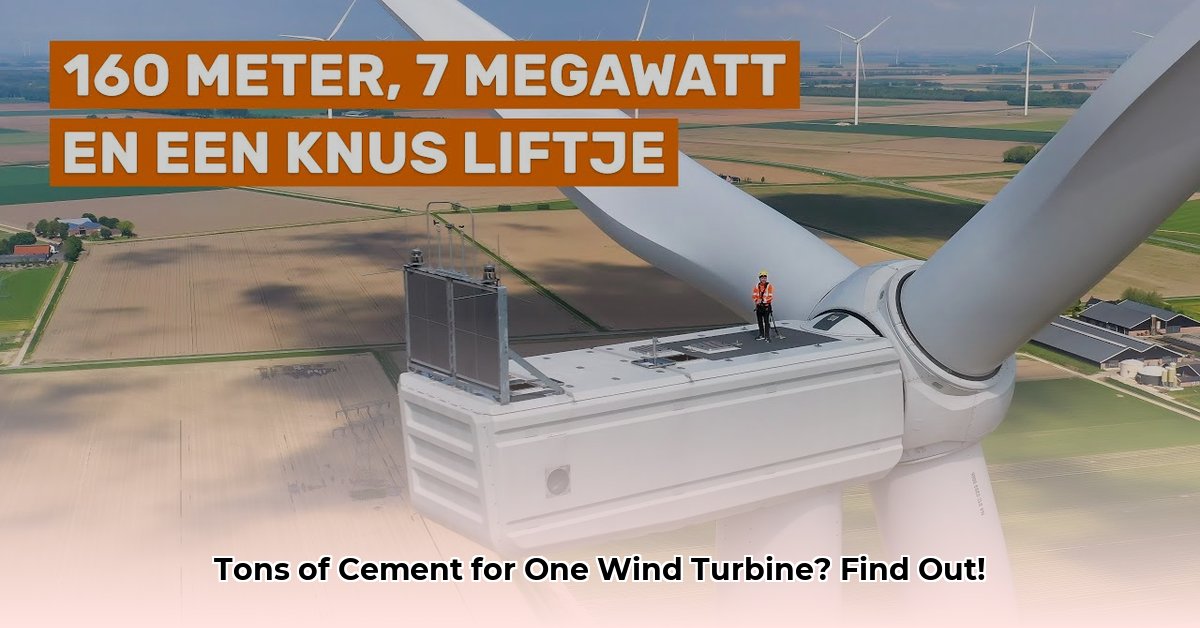Understanding Wind Turbine Foundations and Cement Usage
Wind turbines, essential for harnessing clean energy, require robust foundations to withstand immense forces from wind, spinning blades, and the turbine’s weight. The amount of cement used in these foundations isn’t a fixed number, varying based on several factors. This article provides a comprehensive overview of cement usage in wind turbine foundations, including influencing factors, environmental impact, and future trends.
Foundation Types and Their Influence on Cement Requirements
The foundation type significantly influences cement usage. Two primary types exist:
-
Slab Foundations: Resembling a large concrete disc, these are suitable for smaller turbines (around 1-2 megawatts) on stable ground. While simpler to construct, they typically require a larger volume of concrete, and consequently, more cement.
-
Multi-Pile Foundations: These involve driving multiple concrete piles deep into the ground, distributing the turbine’s weight across these pillars. Multi-pile foundations are preferable for softer or unstable ground. They might use less concrete overall compared to a slab foundation in similar ground conditions, potentially reducing cement usage. Other foundation types include spread footings (wider, shallower pads) and rafts (thicker, broader bases), often used for medium to large turbines.
A helpful table summarizing foundation types and concrete/cement estimates is provided below.
| Turbine Size (Megawatts) | Foundation Type | Estimated Concrete Volume (cubic meters)¹ | Estimated Cement Usage (tons)² |
|---|---|---|---|
| Small (1.5 – 3 MW) | Spread Footing | 200 – 500 | 50 – 125 |
| Medium (3 – 5 MW) | Spread Footing/Raft | 500 – 1000 | 125 – 250 |
| Large (5+ MW) | Raft/Pile | 1000+ | 250+ |
¹ These are rough estimates. Actual volumes vary significantly based on specific project needs.
² Cement usage estimates assume approximately 25% cement in a standard concrete mix. This can vary depending on the mix design.
Factors Affecting Cement Use
Several factors influence the amount of cement required:
-
Turbine Size: Larger turbines generally necessitate larger foundations to support increased weight and forces, leading to higher cement consumption.
-
Ground Conditions: Stable ground often allows for simpler, less material-intensive foundations. Conversely, unstable ground may require more complex designs like multi-pile foundations, which might reduce overall concrete volume but potentially require specialized, high-cement mixes for increased strength.
-
Concrete Mix Design: The specific ratio of cement, water, aggregates (sand, gravel), and additives in the concrete mix significantly impacts its strength and durability. A higher cement content generally yields stronger concrete but increases the carbon footprint. Optimizing the mix design is crucial, balancing strength requirements with environmental considerations. Research suggests that using supplementary cementitious materials (SCMs) like fly ash or slag can reduce the amount of cement needed while maintaining sufficient strength.
Environmental Impact of Cement Production
While wind energy is a clean energy source, cement production, crucial for foundations, has environmental consequences. Cement manufacturing is carbon-intensive, contributing roughly 10% of a wind turbine’s overall lifecycle carbon emissions, or approximately 1 gram of CO2 equivalent (CO2e) per kilowatt-hour (kWh) of electricity generated.
Minimizing Environmental Impact and Future Trends
Several strategies aim to reduce the environmental footprint of wind turbine foundations:
-
Optimizing Concrete Mix Designs: Utilizing lower-strength concrete where appropriate, incorporating SCMs, and exploring alternative binders can reduce cement content and associated emissions.
-
Enhancing Concrete Durability: Longer-lasting concrete reduces the need for replacements, minimizing long-term environmental impact. Ongoing research focuses on improving mix designs and construction techniques for enhanced durability.
-
Innovative Foundation Designs: Prefabricating foundation components in controlled factory environments can reduce material waste and improve quality control.
-
Adaptable Foundations: Designing foundations adaptable for future turbine upgrades minimizes the need for complete foundation replacements when turbines reach the end of their lifespan (typically 20-25 years).
-
Low-Carbon Concrete Alternatives: Research into materials such as geopolymer concrete, which has a lower carbon footprint than traditional cement-based concrete, offers promising solutions for future sustainability.
FAQ: Common Questions about Cement in Wind Turbine Foundations
-
Why is it difficult to give a precise cement amount per turbine? Many factors, including turbine size, foundation type, and ground conditions, influence the final design and material requirements. Each project is unique.
-
What’s being done to reduce the environmental impact of cement production for wind turbines? Research focuses on optimizing concrete mix designs, improving durability, and developing low-carbon concrete alternatives like geopolymer concrete.
-
How does the type of foundation influence the amount of cement needed? Slab foundations tend to use more concrete (and thus cement) than multi-pile foundations, particularly on stable ground. However, in unstable ground conditions, multi-pile foundations may require specialized high-cement mixes for increased strength.
-
Are there any innovative foundation designs that could reduce cement usage? Yes, research exploring prefabricated foundations and adaptable designs for future turbine upgrades shows promise for minimizing material usage and long-term environmental impact.
Glossary of Terms
-
Aggregates: Granular materials like sand, gravel, and crushed stone used in concrete mixes.
-
Concrete: A composite material made from cement, aggregates, and water, forming a hard, durable solid used in construction.
-
Fly Ash: A byproduct of coal combustion used as a supplementary cementitious material in concrete.
-
Geopolymer Concrete: A type of concrete made using industrial byproducts, offering a lower carbon footprint compared to traditional cement-based concrete.
-
Multi-Pile Foundation: A foundation type using multiple concrete piles driven into the ground to support a structure.
-
Slab Foundation: A large, flat concrete pad used as a foundation.
-
Slag: A byproduct of metal smelting used as a supplementary cementitious material in concrete.
-
Supplementary Cementitious Materials (SCMs): Industrial byproducts or other materials used to partially replace cement in concrete, often improving its properties and reducing environmental impact.
Date of Last Update: October 26, 2023
- Water Mill Electricity Generator Provides Free Home Power - December 16, 2025
- Water Wheel Electric Generator Provides Free Home Electricity - December 15, 2025
- Choosing the Right Portable Hydro Turbine for Your Needs - December 14, 2025
















